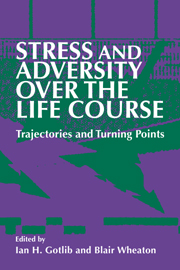1 - Trajectories and turning points over the life course: concepts and themes
Published online by Cambridge University Press: 23 October 2009
Summary
The life course is a path. For most people, this path is far from straight. We use the ideas of trajectories and turning points to divide the life course into complementary parts. A trajectory is the continuation of a direction. It is the inertia in our lives that results from the sum of the forces that propel us toward a destination. A turning point is a disruption in a trajectory, a deflection in the path. Indeed, the essential characteristic of a turning point is that it changes the direction of a trajectory.
The concepts of trajectories and turning points require each other in order to be understood. If we concentrate on trajectories, it leads naturally to the question: What intervenes and disturbs these trajectories? What pushes people away from the path they were on? What puts people back on their former path? Similarly, we cannot conceive of turning points without defining the trajectory as the “norm.” To see an event or a transition as a turning point requires time, stability, and an established baseline.
We think most clearly of turning points as “events,” as crucially important moments in a life history. But turning points need not be dramatic events, or unusual events, or even a single discrete event. Turning points may be difficult to see as they are occurring, because they are only recognized to be turning points as time passes and as it becomes clear that there has been a change in direction.
- Type
- Chapter
- Information
- Stress and Adversity over the Life CourseTrajectories and Turning Points, pp. 1 - 26Publisher: Cambridge University PressPrint publication year: 1997
- 59
- Cited by



